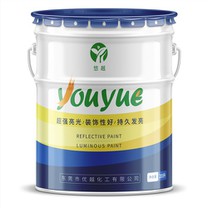After more than 20 years of development of China's automobile industry, most of the skin of buses and buses are stamped by dies, the flatness of the body is greatly improved, the amount of atomic ash is greatly reduced, only the local use of atomic ash to fill the leveling, most of the body is sprayed on the primer with a medium coating, but not coated with atomic ash, the adhesion between the middle coating and the electrophoretic primer is poor, the adhesion of the putty part is very good, and the adhesion when scraping putty in the car is also very good. In response to the new problems that have emerged, we have conducted the following discussion work and proposed solutions to the problems that have arisen.
1. The influence of atomic ash on the adhesion of coating
Using 11 kinds of atomic ash of different grades (including atomic ash produced in Japan and Germany) for experiments, the surface of the baked electrophoretic primer plate (150mm×70mm×1mm) was wiped clean with clean dry gauze (without polishing the paint surface), half coated with atomic ash, 20min from the beginning of atomic ash coating, put into an oven with a constant temperature of 140°C for 30min and taken out. Place at room temperature for 60min, then use 320# water sandpaper to sand the atomic ash surface (do not sand the surface of the electrophoretic primer that is not coated with atomic ash), and let the formed atomic ash dust slurry flow with water to the surface of the electrophoretic primer that is not coated with atomic ash. Dry the sample at room temperature, and then wipe the dust on the surface of the sample with clean dry gauze. After painting the surface of the sample, it is put into an oven with a constant temperature of 140 °C and baked for 30min, and the sample is taken out and placed at room temperature for 60min, and at the same time, the primer plate without atomic ash is coated and painted, and baked in an oven with a constant temperature of 140 °C for 30min, and the sample is taken out and placed at room temperature for 60min, and the adhesion is detected with a scribe.
Experiments show that the adhesion of the coating is poor in half of the uncoated atomic ash, and the adhesion of half of the coated atomic ash is between 0~1 grade.
Due to the addition of high boiling point additives such as leveling agents, anti-settling agents, dispersants and other high-boiling point additives to the water-based electrophoretic primer, these additives will float on the paint surface when baked at high temperature, and these additives may form a weak boundary layer with atomic ash dust, affecting the adhesion between the primer and the middle paint without applying atomic ash.
2. The influence of different processes on adhesion
Different drying processes and dust removal methods were used to investigate the adhesion between the primer and the middle coating.
Whether atomic ash is self-drying or drying, dry grinding or water grinding, as long as the electrophoretic primer is sanded or the surface of the electrophoretic paint is wiped clean with a thinner, and the dust after atomic ash polishing is completely removed, it will not affect the adhesion between the middle coating and the primer, and the adhesion between the middle coating and the primer can reach 0~1 level.
3. Adjust the production formula process of atomic ash to eliminate the primer grinding and solvent rubbing process
In order to simplify the coating process and reduce construction pollution, through the improvement of atomic ash production technology, the process of non-polishing primer and solvent rubbing is adopted, for this purpose, the resin production formula and process of atomic ash are adjusted, and a large number of fillers are screened and blended. The upper part of the electrophoretic primer plate is coated with atomic ash, and the timing starts from the ashing, and after being placed at room temperature for 20min, the sample is put into an oven with a constant temperature of 140 °C for 30min and taken out, and then the atomic ash surface is polished with 320# water sandpaper, so that the formed atomic ash dust slurry flows with water to the surface of the electrophoretic primer that is not coated with atomic ash. Allow to dry at room temperature and wipe off the surface of dust. The surface of the sample is sprayed and put into a 140°C oven at a constant temperature for 30min. After the sample is placed at room temperature for 60 min, the adhesion is detected with a scribe.
Experiments show that the adhesion between the middle coating and the primer can be improved by adjusting the formula of atomic ash, so that the dust basically does not affect the adhesion. If the dust after the grinding of atomic ash does not affect the adhesion between the middle coating and the primer, that is, the adhesion between the middle coating and the primer reaches 0~1 grade, one or two common raw materials must be removed from the atomic ash.
The situation of water milling and painting after the atomic ash is self-drying and the water milling and painting after the high temperature baking of atomic ash is the same, that is, the natural curing and baking of atomic ash has the same effect on the adhesion of electrophoretic primer and middle coating.
If the electrophoretic primer is sanded or the surface of the electrophoretic paint is wiped with a thinner, even if commercially available atomic ash is used, the dust after the atomic ash polishing will not affect the adhesion between the middle coat and the primer, that is, the adhesion between the middle coat and the primer can still reach 0~1 grade.









